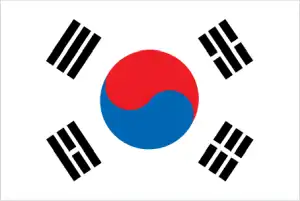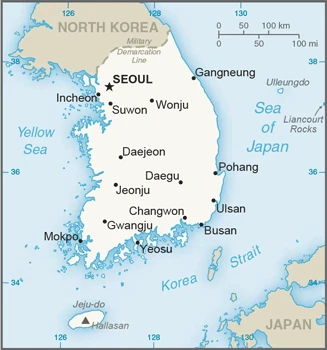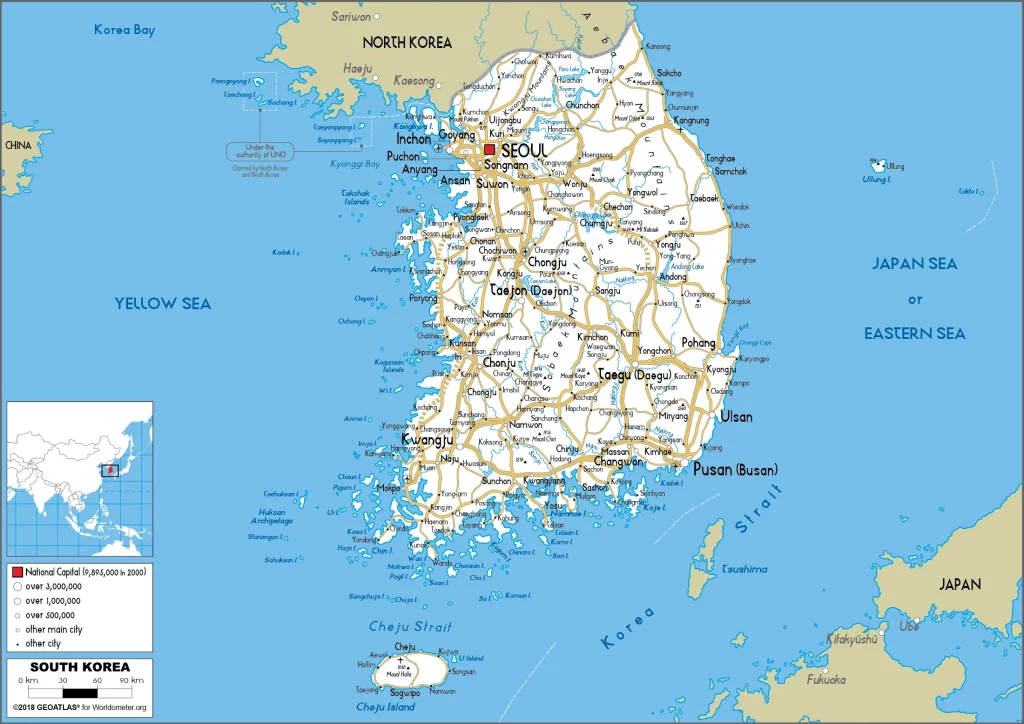South Korea Google Maps is a site/tool that offers a wide range of map views (topographic, satellite, street view) and navigation options, with little effort on your part, yet efficiently. If you need to plan a trip to a new place like South Korea, Google maps are available on desktop, mobile, or tablet. This Google maps and information page is dedicated to South Korea, Asia (22 countries), showing its location, country facts, details about its capital city Seoul, bordering countries like North Korea, and plenty of other information which may be interesting when you visit this Asian state.
Quick links: Google Maps South Korea, Seoul Google maps, Driving Directions South Korea, Printable Road Map.

About South Korea in a nutshell
- Conventional short form of the name: South Korea
- The conventional long form of the name: Republic of Korea
- Local long form: Taehan-minguk,
- Local short form: Hanguk,
- Former name(s): N/A
- Etymology: Derived from the Chinese name for Goryeo, which was the Korean dynasty that united the peninsula in the 10th century A.D.; the South Korean name Hanguk derives from the long-form, Taehan-Minguk, which is itself a derivation from Daehan-Jeguk, which means the Great Empire of the Han; Han refers to the Samhan or the Three Han Kingdoms (Goguryeo, Baekje, and Silla from the Three Kingdoms Era, 1st-7th centuries A.D.).
- The legal system in South Korea: mixed legal system combining European civil law, Anglo-American law, and classical Chinese thought.
- Climate: There are four distinct seasons. Winters are dry and bitterly cold. Summers are hot and humid.
- The national symbols are Taegeuk (yin yang), Hibiscus syriacus (Rose of Sharon), and Siberian tiger; the national colors: are red, white, blue, and black.
- Internet TLD: .kr
Monuments from almost all the significant periods of the four millennia of Mongol, Japanese and Manchu conquest are on the World Heritage List. The dolmens of Gocsang, Hwaszun, and Ganghwa are monuments to the megalithic culture of the 1st millennium BC. The Bulguksa Temple, built in the 8th century AD, and the Seokguram Cave Temple are among the most important Buddhist monuments, as is the Heinsa Temple, which houses the Tripitaka collection of 13th-century Buddhist texts written on more than 80 000 wooden tablets, and which is remarkably well preserved. The statues, pagodas, and temple remains of Gyongju are also relics of the heyday of Korean Buddhism in the 7th-10th centuries. Jongmyo Shrine is the oldest Confucian monument in Korea and preserves relics of the last Korean ruling family, the Joseon dynasty, from the 15th century. Not far from the shrine, the Changdokgung Palace complex, a monument of East Asian palace architecture, was built in the early 15th century. The Hwaszong Fortress, built in the late 18th century, is almost 6 km long and surrounds the imperial seat of Su-won.
Half of all Koreans are named Kim, Lee, Park, or Choi.
Background
The first recorded kingdom (Choson) on the Korean Peninsula dates from approximately 2300 B.C. Over the subsequent centuries, three main kingdoms – Kogoryo, Paekche, and Silla – were established on the Peninsula. By the 5th century A.D., Kogoryo emerged as the most powerful, controlling much of the Peninsula and part of Manchuria (modern-day northeast China). However, Silla allied with the Chinese to create the first unified Korean state in the late 7th century (688). Following the collapse of Silla in the 9th century, Korea was unified under the Koryo (Goryeo: 918-1392) and the Chosen (Joseon: 1392-1910) dynasties.
Korea became the object of intense imperialistic rivalry between the Chinese (its traditional benefactor), Japanese, and Russian empires in the latter half of the 19th and early 20th centuries. Following the Sino-Japanese War (1894-95) and the Russo-Japanese War (1904-1905), Korea was occupied by Imperial Japan. In 1910, Tokyo formally annexed the entire Peninsula. Korea regained its independence following Japan’s surrender to the US and its allies in 1945. After World War II, a democratic government (Republic of Korea, ROK) was set up in the southern half of the Korean Peninsula. In contrast, a communist-style government was installed in the north (Democratic People’s Republic of Korea, DPRK). During the Korean War (1950-53), US troops and UN forces fought alongside ROK soldiers to defend South Korea from a DPRK invasion supported by communist China and the Soviet Union. A 1953 armistice split the peninsula along a demilitarized zone at the 38th parallel. PARK Chung-hee took over leadership of the country in a 1961 coup. During his regime from 1961 to 1979, South Korea achieved rapid economic growth, with per capita income rising to roughly 17 times the level of North Korea in 1979.
Park was assassinated in 1979, and Army general Chun Doo-hwan succeeded Park in a coup two months after the assassination. Subsequent years were marked by political turmoil and continued authoritarian rule under the guise of democracy. South Korea held its first free presidential election under a revised democratic constitution in 1987, with former Army general ROH Tae-woo winning a close race. In 1993, KIM Young-sam (1993-98) became the first civilian president of South Korea’s new democratic era. President KIM Dae-Jung (1998-2003) won the Nobel Peace Prize in 2000 for his contributions to South Korean democracy and his “Sunshine” policy of engagement with North Korea. President PARK Geun-Hye, daughter of former ROK President PARK Chung-hee, took office in February 2013 as South Korea’s first female leader. In December 2016, the National Assembly passed an impeachment motion against President PARK over her alleged involvement in a corruption and influence-peddling scandal, immediately suspending her presidential authorities. The impeachment was upheld in March 2017, triggering an early presidential election in May 2017 won by MOON Jae-in.
South Korea hosted the Winter Olympic and Paralympic Games in February 2018, in which North Korea also participated. Discord with North Korea has permeated inter-Korean relations for much of the past decade, highlighted by the North’s attacks on a South Korean ship and island in 2010, the exchange of artillery fire across the DMZ in 2015, and multiple nuclear and missile tests in 2016 and 2017. North Koreas participation in the Winter Olympics, dispatch of a senior delegation to Seoul, and three inter-Korean summits in 2018 appear to have ushered in a temporary period of respite, buoyed by the historic US-DPRK summits in 2018 and 2019. Nevertheless, relations were stagnant in 2020 and 2021.
Geography
Over 80% is mountainous, and two-thirds is forested. The flattest and most populous parts lie along the west coast and the extreme south.

South Korea is exciting with its rich culture, diverse landscapes, and futuristic architecture. It is bordered to the north by North Korea, to the west and south by China, and the east by Japan.
This state is located in Eastern Asia, the southern half of the Korean Peninsula bordering the Sea of Japan and the Yellow Sea, under the coordinates of 37 00 N, 127 30 E, covering an area of 99,720 sq km with a coastline of 2,413 km. South Korea is slightly smaller than Pennsylvania; slightly larger than Indiana.
South Korea has 237 km of land boundaries and borders (1 nation): North Korea has 237 km.
Mostly hills and mountains, vast coastal plains in the west and south, with Halla-san 1,950 m as the highest point of South Korea, while the Sea of Japan 0 m as the lowest point, causing a mean elevation of 282 m throughout the country. With 99,720 sq km, South Korea has 96,920 sq km of land and 2,800 sq km of water surface area.
Strategic location on Korea Strait; about 3,000 mostly small and uninhabited islands lie off the western and southern coasts.
The climate in South Korea is as follows: Temperate, with rainfall heavier in summer than winter and cold winters.
When you visit South Korea, the natural hazards shall be considered: Occasional typhoons bring high winds and floods; low-level seismic activity every day in southwest volcanism: Halla (1,950 m) is considered historically active, although it has not erupted in many centuries.
The following major health-threatening issues shall be considered when visiting South Korea: degree of risk: very high (2020), bacterial and protozoal diarrhea, hepatitis A, typhoid fever, malaria, dengue fever, schistosomiasis, rabies, meningococcal meningitis, Lassa fever.
Current environmental issues affecting the Korean people: air pollution in large cities; acid rain; water pollution from the discharge of sewage and industrial effluents; drift net fishing; solid waste disposal; transboundary pollution.
Google Maps South Korea
The capital and other divisions
Capital city: Seoul found under the coordinates 37 33 N, 126 59 E, applying the time zone UTC+9 (14 hours ahead of Washington, DC, during Standard Time), using the following daylight saving time: none.
Seoul is the capital of South Korea, a country in East Asia. It is the largest city in South Korea and one of the world’s most populous cities. The city’s population is expected to reach 20 million by 2045. Seoul is a central hub for politics, economy, cultural affairs, education, and transportation. Seoul was occupied by Japan from 1910 to 1945 and again by Soviet Union forces from 1945 to 1947 during the Korean War. The city was founded in 18 BC and became a government base in 1948 following the division of Korea into North and South. It is often called “the City of Trees,” with around 30% of Seoul’s territory covered by greenery.
South Korea became independent on 15 August 1945 (from Japan), and its national holiday is Liberation Day, 15 August (1945).
Administrative divisions: 9 provinces (do, singular and plural), 6 metropolitan cities (gwangyeoksi, singular, and plural), 1 particular city (teugbyeolsi), and 1 remarkable self-governing city (Teukbyeoljachisi) provinces: Chungbuk (North Chungcheong), Chungnam (South Chungcheong), Gangwon, Gyeongbuk (North Gyeongsang), Gyeonggi, Gyeongnam (South Gyeongsang), Jeju, Jeonbuk (North Jeolla), Jeonnam (South Jeolla) metropolitan cities: Busan (Pusan), Daegu (Taegu), Daejeon (Taejon), Gwangju (Kwangju), Incheon (Inchon), Ulsan, particular city: Seoul unique self-governing city: Sejong.
People and society
Inhabited for the last 2000 years by a single ethnic group. The nuclear family is replacing traditional extended households. Since the 1953 armistice, the Koreas have remained technically at war. Reunification is the ultimate goal, but the two sides fluctuate between harsh rhetoric or belligerence and conciliation, allowing cross-border family reunions.
The population in South Korea is 51,715,162 (July 2021 estimate), with an average of 0.26% (2021 estimate) change. That means South Korea is the No. 28 on the world’s populated rank list. With an average of 43.2 years median age (41.6 years for males and 41.6 years for women), South Korea ranks No. 29 on the globe’s median age rank list.
The people living in this country are the Korean(s) (noun) or Korean (adjective) and belong mainly to the following ethnic groups: homogeneous.
They speak Korean, English (widely taught in elementary, junior high, and high school) languages and practice the following religions: Protestant 19.7%, Buddhist 15.5%, Catholic 7.9%, none 56.9% (2015 estimate). Note: many people also carry on at least some Confucian traditions and practices.
We can conclude the following about the population in South Korea: With approximately 70% of the country considered mountainous, the country’s population is primarily concentrated in the lowland areas, where density is relatively high. Gyeonggi province in the northwest, which surrounds the capital of Seoul and contains the port of Incheon, is the most densely populated province. Gangwon in the northeast is the least populated. In South Korea, about 40.8% (2021) of the total population lives in cities. Most of them reside in the following municipalities: 9.968 million, Seoul (capital city), 3.466 million, Busan, 2.818 million, Incheon, 2.191 million, Daegu (Taegu), 1.569 million, Daejon (Taejon), 1.524 million, Gwangju (Kwangju) (2021).
Industry
Worlds biggest shipbuilder. High-tech goods and cars: rising demand from China. Strong regional competition. Aging population.
After the 1950-53 war with North Korea, South Korea emerged as one of the 20th century’s most remarkable economic success stories, becoming a developed, globally-connected, high-technology society within decades. In the 1960s, GDP per capita was comparable with levels in the poorest countries in the world. In 2004, South Koreas GDP surpassed one trillion dollars., Beginning in the 1960s under President PARK Chung-hee, the government promoted the import of raw materials and technology, encouraged saving and investment over consumption, kept wages low, and directed resources to export-oriented industries that remain important to the economy to this day. Growth surged under these policies and frequently reached double-digits in the 1960s and 1970s. Growth gradually moderated in the 1990s as the economy matured but remained strong enough to propel South Korea into the ranks of the advanced economies of the OECD by 1997. These policies also led to the emergence of family-owned chaebol conglomerates such as Daewoo, Hyundai, and Samsung, which retained their dominant positions even as the government loosened its grip on the economy amid the political changes of the 1980s and 1990s.
The Asian financial crisis of 1997-98 hit South Koreas companies hard because of their excessive reliance on short-term borrowing, and GDP ultimately plunged by 7% in 1998. After the crisis, South Korea tackled difficult economic reforms, including restructuring some chaebols, increasing labor market flexibility, and opening more foreign investment and imports. These steps lead to a relatively rapid economic recovery. South Korea also began expanding its free trade agreements to help bolster exports and has since implemented 16 free trade agreements covering 58 countries, including the United States and China,that collectively cover more than three-quarters of global GDP. In 2017, the election of President MOON Jae-in brought a surge in consumer confidence, in part, because of his successful efforts to increase wages and government spending. These factors combined with an uptick in export growth to drive real GDP growth to more than 3%, despite disruptions in South Korea’s trade with China over deploying a US missile defense system in South Korea. In 2018 and beyond, South Korea will contend with gradually slowing economic growth – in the 2-3% range – not uncommon for advanced economies. This could be partially offset by efforts to address challenges arising from its rapidly aging population, inflexible labor market, the continued dominance of the chaebols, and heavy reliance on exports rather than domestic consumption. Socioeconomic problems also persist and include rising inequality, poverty among the elderly, high youth unemployment, long working hours, low worker productivity, and corruption.
South Korea is rich in the following natural resources: Coal, tungsten, graphite, molybdenum, lead, and hydropower potential.
Electronics, telecommunications, automobile production, chemicals, shipbuilding, and steel are the main industrial sectors.
The country’s export sectors are robust in integrated circuits, cars and vehicle parts, refined petroleum, ships, and office machinery (2019), partnering with these nations: China 25%, the United States 14%, Vietnam 9%, Hong Kong 6%, Japan 5% (2019). The export trade resulted in $606.71 billion. Note: Data are in current year dollars (2020 estimate). In a global rank of the export, values resulted in South Korea’s position of 9.
Land use in South Korea: 63.9% (2018 estimate) forest, 18% (2018 estimate) other.
The arable land area is 15.3% (2018 estimate), and the agricultural land is 18.1% (2018 estimate). Land use for permanent crops 2.2% (2018 estimate), permanent pasture 0.6% (2018 estimate). The sum of the area of the irrigated land is 7,780 sq km (2012).
The main agro-industrial products of South Korea are rice, vegetables, cabbages, milk, onions, pork, poultry, eggs, tangerines/mandarins, and potatoes.
The country typically needs to import: crude petroleum, integrated circuits, natural gas, refined petroleum, and coal (2019), partnering with the following nations: China 22%, the United States 12%, Japan 9% (2019) in a sum value of $540.96 billion. Note: data are in current year dollars (2020 estimate) $607.54 billion. Note: data are in current year dollars (2019 estimate) $649.23 billion. Note: data are in current year dollars (2018 estimate). This sum value on the global ranking list of imports resulted in South Korea 9.
South Korea Driving Directions
In this post, you learned about South Korea, Eastern Asia, and the southern half of the Korean Peninsula bordering the Sea of Japan and the Yellow Sea. We published some basic information about its capital Seoul, and the Korean nation.
Are you interested in visiting South Korea and looking for driving directions? Click here to plan your route, or see a printable road map of South Korea below for an overview of the route network.
Printable map of South Korea
Did you know about South Korea?
South Korea is an exciting country with a lot to offer. For example, it is one of the most technologically advanced countries globally. It has a very high internet usage rate, and almost all of its citizens have access to smartphones. Additionally, South Korea is known for its delicious food. There are many different types of food available, and each region has its specialty. If you’re looking for an enjoyable travel experience, you should consider visiting South Korea!
After virtually visiting South Korea, you may also be interested in the neighboring country: North Korea.
If you liked our Google map and South Korea information page,
please share it with others or save the link https://www.drivingdirections.net in your bookmarks.

